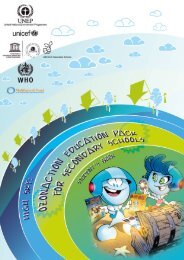Chapter 2. Progress towards the EFA goals - Unesco
Chapter 2. Progress towards the EFA goals - Unesco
Chapter 2. Progress towards the EFA goals - Unesco
Create successful ePaper yourself
Turn your PDF publications into a flip-book with our unique Google optimized e-Paper software.
PROGRESS TOWARDS THE <strong>EFA</strong> GOALS<br />
The quality of education<br />
between indigenous and non-indigenous students<br />
were explained by <strong>the</strong> poor quality of schools<br />
serving indigenous students (McEwan, 2004).<br />
These findings demonstrate that improving school<br />
quality and narrowing differences among schools<br />
will reduce inequality in student performance. In <strong>the</strong><br />
mid-1990s, Brazil created <strong>the</strong> Fundo de Manutenção<br />
e Desenvolvimento do Ensino Fundamental e de<br />
Valorização do Magistério (FUNDEF), a fund to<br />
finance subnational spending on primary and lower<br />
secondary education to ensure a more equitable<br />
distribution of per-student spending across <strong>the</strong><br />
country. Preliminary evidence suggests that this<br />
redistributive policy has narrowed learning<br />
inequalities, though only by a small amount (Gordon<br />
and Vegas, 2005). In o<strong>the</strong>r countries, per-student<br />
funding formulas have been introduced to ensure<br />
that resources are more equitably distributed<br />
across regions and population groups.<br />
Box <strong>2.</strong>23: Improving equity in Poland<br />
In 1999, Poland started providing an additional year of general<br />
education before students were split into upper secondary school<br />
tracks. By using three rounds of PISA it is possible to assess <strong>the</strong><br />
reform’s impact on equity:<br />
From 2000 to 2003, average variation in student performance<br />
in science fell from 51% of <strong>the</strong> OECD average to 15%. By 2006,<br />
Poland had one of <strong>the</strong> lowest levels of variation in science<br />
performance among participating countries (Figure <strong>2.</strong>41).<br />
Improvement in equity came about at <strong>the</strong> same time as general<br />
improvement in performance. For example, average reading<br />
performance of 15-year-olds increased by twenty-nine score<br />
points between 2000 and 2006.<br />
Most of <strong>the</strong> improvement occurred among students with poor<br />
performance. From 2000 to 2006, <strong>the</strong> proportion of students<br />
failing to score above level 1 in reading competency fell from<br />
23% to 16%.<br />
Students in <strong>the</strong> vocational track appear to have benefited<br />
most from greater integration of <strong>the</strong> system.<br />
School-based disparities do not operate in isolation.<br />
In many cases <strong>the</strong>y interact with and reinforce<br />
wider disadvantage. Parental income and education,<br />
home language and o<strong>the</strong>r factors are all strongly<br />
associated with learning achievement levels, as<br />
<strong>the</strong> following cases demonstrate:<br />
In Pakistan, children from families in <strong>the</strong> richest<br />
third of <strong>the</strong> population scored on average<br />
between 0.25 and 0.5 of a standard deviation<br />
higher than children from <strong>the</strong> poorest households<br />
(Das et al., 2006).<br />
In Peru, in national assessments of ma<strong>the</strong>matics<br />
conducted in 2004, sixth grade pupils whose<br />
mo<strong>the</strong>r tongue was Spanish scored more than<br />
one standard deviation higher than children<br />
whose mo<strong>the</strong>r tongue was an indigenous<br />
language (Cueto et al., 2009).<br />
Fifth grade students from Cameroon’s Bamileke<br />
language group scored 48% on <strong>the</strong> PASEC<br />
literacy test, compared with 56% for students<br />
from <strong>the</strong> Ewondo language group (Fehrler and<br />
Michaelowa, 2009).<br />
In <strong>the</strong> 2006 SERCE assessments in Latin America<br />
and <strong>the</strong> Caribbean, students who undertook a<br />
significant amount of work, inside and outside<br />
<strong>the</strong> home, had lower levels of ma<strong>the</strong>matics<br />
achievement on average. For example, in<br />
El Salvador, sixth graders who worked had<br />
average scores 6% lower than those of children<br />
who did not (Bonnet, 2009).<br />
Source: OECD (2007b).<br />
A longitudinal study in Ethiopia found that 42%<br />
of 12-year-olds who had lost <strong>the</strong>ir mo<strong>the</strong>rs<br />
between ages 8 and 12 were unable to read,<br />
while for children with both parents living <strong>the</strong><br />
figure was 23% (Himaz, 2009). The study<br />
attributed <strong>the</strong> difference to lower school<br />
enrolment among orphans, as well as poorer<br />
performance in school.<br />
In countries with more equitable systems,<br />
children’s backgrounds are less important in<br />
determining levels of achievement. In countries<br />
where <strong>the</strong>re is a strong relationship between<br />
student background and performance, or where<br />
large differences in student background exist,<br />
reducing differences in school quality is unlikely<br />
to be enough to improve equity significantly.<br />
Targeted programmes to improve learning among<br />
children who are being left behind will also be<br />
needed (see <strong>Chapter</strong> 3). In Mexico, <strong>the</strong> Consejo<br />
Nacional de Fomento Educativo (CONAFE) provides<br />
supplemental funds, learning materials – including<br />
textbooks in indigenous languages – and teacher<br />
support to schools in areas marked by consistent<br />
underperformance and disadvantage. Evaluations<br />
indicate that <strong>the</strong>se efforts have narrowed <strong>the</strong> gap<br />
in primary school ma<strong>the</strong>matics scores, though<br />
<strong>the</strong>y have had little impact on Spanish scores<br />
(Vegas and Petrow, 2008).<br />
School-based<br />
disparities interact<br />
with student<br />
background and<br />
socio-economic<br />
status<br />
111
















